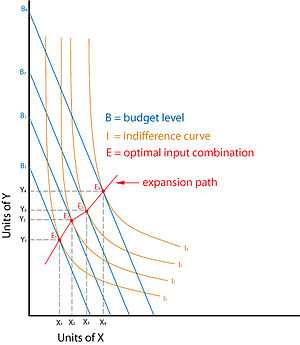Expansion path

In economics, an expansion path (also called a scale line[1]) is a line connecting optimal input combinations as the scale of production expands.[2] A producer seeking to produce the most units of a product in the cheapest possible way attempts to increase production along the expansion path.[3]
Economists Alfred Stonier and Douglas Hague defined expansion path as "that line which reflects least cost method of producing different levels of output, when factor prices remain constant."[4] The points on an expansion path occur where budget level and the purchaser's indifference curve are tangents. As a producer's budget level increases, each of these points can be connected in a line joining tangency points of isoquants and isocosts (with input prices held constant).[5] If an expansion path forms a straight line, the production technology is considered homothetic (or homoethetic).[6] In this case, the ratio is always the same, and the inputs can be adjusted based on this ratio for any budget. A Cobb–Douglas production function has an expansion path which is a straight line through the origin.[6]
References
- ↑ Jain, TR; Khanna OP (2008). Economics. VK Publications, ISBN 978-81-87344-77-3
- ↑ Hirschey, Mark (2008). Managerial economics. Cengage Learning, ISBN 978-0-324-58886-6
- ↑ Prusty, Sadananda (2010). Managerial Economics. PHI Learning Pvt. Ltd., ISBN 978-81-203-4094-7
- ↑ Stonier, Alfred W.; Hague, Douglas C. (1980). A textbook of economic theory, 5th edition. Longmans ISBN 978-0-582-29530-8
- ↑ Salvatore, Dominick (1989). Schaum's outline of theory and problems of managerial economics. McGraw-Hill, ISBN 978-0-07-054513-7
- ↑ 6.0 6.1 Rasmussen, Svend (2011). Production Economics: The Basic Theory of Production Optimisation. Springer, ISBN 978-3-642-14609-1